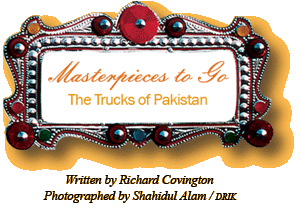
 nder the shade of a colossal banyan tree, Karachi truck painter Haider Ali, 22, is putting the finishing touches on his latest creation: a side-panel mural of Hercules subduing a lion, rendered in iridescent, undiluted hues of purple, yellow, red and green. His 10-year-old nephew, Fareed Khalid, applies a preparatory undercoat of white paint to the taj, the wooden prow that juts above the truck’s cab like a crown. Like Ali’s father, who first put a brush into his son’s hand at age eight, Haider is carrying on a master-apprentice tradition with Fareed, who spends his afternoons in the painter’s workshop after mornings in school.
nder the shade of a colossal banyan tree, Karachi truck painter Haider Ali, 22, is putting the finishing touches on his latest creation: a side-panel mural of Hercules subduing a lion, rendered in iridescent, undiluted hues of purple, yellow, red and green. His 10-year-old nephew, Fareed Khalid, applies a preparatory undercoat of white paint to the taj, the wooden prow that juts above the truck’s cab like a crown. Like Ali’s father, who first put a brush into his son’s hand at age eight, Haider is carrying on a master-apprentice tradition with Fareed, who spends his afternoons in the painter’s workshop after mornings in school.
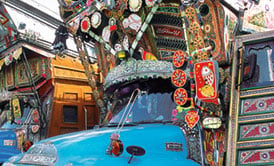 |
 |
Lying on his back beneath the truck—a 10-ton, six-wheel Japanese Hino—a body repairman strings a chain of hammered steel peepul leaves to dangle around the chassis. When the truck is under way, these metal leaves will clang together, creating a cacophony that is music to a driver’s ears. Above the chain man, a carpenter is chiseling out the wooden panels adorning the doors. Nearby, the truck’s owner sits observing
the work in progress as an outdoor barber lathers the man’s face for a shave. A crooning pop tune crackles out of a tinny radio as a pair of pariah kites flutters noisily home to roost. Welcome to Garden Road, the traffic-choked heart of Karachi’s booming truck-painting industry.
All across Pakistan, this rolling folk art has turned village lanes, city streets and long-distance highways into a national gallery without walls, a free-form, kaleidoscopic exhibition in perpetual motion. The vast majority of Pakistan’s trucks, buses and motorized rickshaws are riots of color, bedizened top to bottom with eye-popping landscapes, portraits, calligraphic poetry, religious verses and wisecracking expressions of star-spangled banter. Only the biggest, blandest container freight trucks, the 18-wheeler rigs, escape decoration, looking naked by comparison.
The dazzling, eclectic choice of images is a cultural grab bag, mingling with equal gusto East and West, secular and sacred. Pakistani film stars like Musarrat Shaheen and athletes like cricket legend Imram Khan vie for space with figures from Greek myth and European icons from the Mona Lisa to Princess Diana. Decked out with romanticized visions of Pakistani military heroes like Sarwar Shaheed, F-16 fighter jets and Ghauri missiles, some trucks become roving patriotic billboards. Others give prominence to religious shrines like the Ka’bah in Makkah and the Faysal Mosque in Islamabad, or they display verses writ large on an image of an open Qu’ran. The Prophet’s winged horse, Buraq, is a favorite emblem, handily symbolizing trustworthy devotion and speed. Dreamlike scenes of wooded lakes and snow-capped mountains, alpine hunting lodges and tigers chasing deer are framed by flowers and diamond-shaped reflective strips in bright red, orange and green.
In the cabs, faux marble Formica-paneled doors open onto gaudy treasure caves filled with artificial roses and marigolds spun of silk and satin. Tiny faceted mirrors and rick-rack ring the windshields, while swaying pompoms and wall clocks
festooned with flashing lights hang from the ceilings. Giant heavy-lidded eyes painted on side panels and pastel-colored scarves fluttering from cab windows are intended to ward off the evil eye.
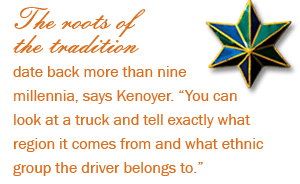 Americans got a tiny taste of Pakistani truck painting in the summer of 2002 at the Smithsonian Folklife Festival, when Ali and bodywork expert Jamil ud-Din brought a truck from Karachi to Washington, D.C. They decorated it right there on the National Mall, as outdoor artists-in-residence. As a talent scout for the festival’s Silk Road theme, truck aficionado Jonathan Mark Kenoyer, an anthropology professor at the University of Michigan and a top us scholar of Pakistani culture, chose the pair for their versatility in incorporating the country’s disparate styles of truck art. Their finished masterpiece, a 1976 Bedford, is now part of the Smithsonian’s permanent collection.
Americans got a tiny taste of Pakistani truck painting in the summer of 2002 at the Smithsonian Folklife Festival, when Ali and bodywork expert Jamil ud-Din brought a truck from Karachi to Washington, D.C. They decorated it right there on the National Mall, as outdoor artists-in-residence. As a talent scout for the festival’s Silk Road theme, truck aficionado Jonathan Mark Kenoyer, an anthropology professor at the University of Michigan and a top us scholar of Pakistani culture, chose the pair for their versatility in incorporating the country’s disparate styles of truck art. Their finished masterpiece, a 1976 Bedford, is now part of the Smithsonian’s permanent collection.
As co-director of the Harappa Archaeological Research Project, based at the ancient Indus Valley site that flourished nearly 5000 years ago, Kenoyer takes a very long view of truck painting. The roots of the tradition date back more than nine millennia, he says, to well before the mud-brick city of Harappa was constructed.
Today’s truckers are the successors of Neolithic traders who moved goods along roughly similar routes from the coast of Pakistan inland to Central Asia, using what artifacts show were heavily decorated camel caravans.
Today, Kenoyer says, “the paint jobs identify competing ethnic groups, just as the different designs did on ancient pottery and later on fabrics and carpets. You can look at a truck and tell exactly what region it comes from and what ethnic group the driver belongs to.”
Truck and bus painting and bodywork are also big business. In Karachi alone, a port city of 14 million on the Arabian Sea, more than 50,000 people toil in small, family-run workshops comprised of apprentices and highly trained artisans, each with his well-defined specialty. Dominated by the painstaking ethic of proudly independent craftsmen, this time-consuming manufacture is the opposite of mass production: Every hand-painted truck, bus and rickshaw, despite sharing numerous signs and symbols, virtually screams its uniqueness.
A stroll through the warren
of streets and alleys of the dusty Garden Road district, one of five Karachi neighborhoods devoted to vehicle decoration, offers an education in the truck painter’s art. In one open-air stall close to Ali’s workshop, a dapper metalworker, improbably clothed in an immaculate white knee-length tunic with matching prayer cap, hammers away at prefabricated nickel-steel mud-guard flaps, creating repoussé tigers and chevron designs that an assistant subsequently tints bright red, yellow and green. In a hole-in-the-wall shop nearby, a man surrounded by stacked cans of pigments and powders mixes electric orange fluorescent compound into resin varnish to produce vividly glossy lacquers that glow in the dark. Down one lane, a 14-year-old boy brushes an iron radiator grille with fuming acid to remove rust.
Rows of shops are filled with all manner of outlandish ornaments and tantalizing accessories. Suspended beneath an array of beadwork eagles in one tiny emporium, shimmering gilt peacocks and fish twirl gently in the breeze. Another store is crammed with plastic flowers and miniature chandeliers to furnish cab interiors. Hubcaps with spinning metal cones spill out of another. Nearby, the specialty is shiny model planes that flash red and green lights.
Truck owners spend small fortunes on all this. A decent paint job costs $500 to $1000—perhaps more, depending on how splendiferous it is. Body decoration and repair can easily run an extra $2000. All told, a basic painting and body job adds up to a minimum of $2500, equivalent to two years of the average truck driver’s salary. As a rule, however, owners or owner-drivers pay for the decoration, although hired drivers employed by a company are often free to choose whatever illustrations they like.
This labor-intensive operation usually takes six to 10 weeks. During this period, many drivers hover around the workshops like part of the extended family, suggesting possible subjects and alterations, earning nothing during the time their truck is being spiffed up. Unbelievably, the majority of truckers splurge on a full makeover of their vehicles every three or four years.
Ali, who receives most of his commissions via word of mouth, always signs his work, and this discreet advertising regularly attracts new clients.
“Owners get what they pay for,” the artist explains. “The fancier the painting, the more it costs.” Recently, one particularly demanding trucking magnate lavished more than $13,000 on outfitting his rig. The mammoth undertaking took more than four months.
“It’s worth the expense,” volunteers truck owner Doda Khan after his shave at Ali’s workshop. “More people will hire me if I have a beautifully painted truck.” Khan is a native of Quetta who makes his living transporting wood and glass in Sindh, the province of which Karachi is the capital.
“Truckers don’t even spend so much money on their own houses,” marvels Durriya Kazi, head of the department of visual studies at the University of Karachi and a walking encyclopedia of Pakistani truck-decoration lore. “I remember one driver who told me that he put his life and livelihood into the truck. If he didn’t honor it with the proper paint job, he would feel he was being ungrateful.”
Kazi is convinced that truck art tells a broader truth about Pakistani society’s pervasive desire to heighten reality. “We have an irresistible tendency to decorate everything—from lowly tape cassette players to brides to trucks—because we’re such dreamers and escapists,” she declares. “It’s all part of our need to intensify experience, perhaps to make us forget our drab lives.”
With her angular good looks, long, striking gray hair and upper-class accent, Kazi seems an unlikely champion of truck-painting esthetics. Her passion for this underappreciated art was piqued a decade ago when she dreamed up the idea of having her university students decorate a truck, fill it with paintings and drive the mobile magnum opus around Pakistan.
“The idea was to see how ordinary people would react,” Kazi explains in her home in north Karachi, where photographs of painted trucks share space with war-themed Afghan kilims depicting tanks and helicopters, kitschy cinema posters featuring turbaned Lotharios, old-fashioned metal talcum-powder boxes with demurely smiling housewives, intricately embroidered Sindhi wall hangings and a whimsical Ali Baba hoard of eclectic folk art exotica. “Art has become such an elite activity and so marginalized in this country that I wanted to try to take it out of the galleries and literally get it on the road,” she adds.
Reaction to this nomadic student exhibition was largely favorable, even if the professional truck artists turned out
to be the toughest critics. “The Garden Road painters said the pictures were interesting, ‘but you’ve painted them very badly,’” the professor recalls. “The students were flabbergasted. They thought they possessed superior talents just because they were in art school, but they soon realized how sophisticated the technique really is. The paint has to be applied in delicate layers and glazes. You can’t just brush it on the way you do with oil paint.”
Bangladesh and Thailand have their painted rickshas. Japan has its semitrailers strung with flashing, custom-fitted lights. The Philippines are reputed for their garish “Jeepnies,” collective taxis whose bodies are built atop vintage us Jeep chassis. In Haiti, “tap-taps,” jaunty buses dressed up in comic-book colors, ply the island’s roads. But nowhere do vehicle artists get quite as carried away as in Pakistan. Kazi, who holds a master’s degree in English literature, trained as a sculptor in the uk and now creates interactive exhibitions with local folk artists, set out to discover why. After 10 years of scouring workshops, haunting ornament shops and chatting up truck dealers, transport company proprietors, drivers, artists, craftsmen and suppliers, the art professor has pieced together an informal history of truck painting that she someday hopes to turn into a book.
In the late 1940’s, she says, when trucks first began to deliver long-haul goods, each company developed its own painted logo so that illiterate people, then and now the majority of Pakistanis, could recognize who owned the trucks. Displays of solidarity with the infant nation, partitioned from India in 1947, were always a sure bet. One enterprisingly loyal transporter featured a crescent and star modeled on the Pakistani flag; another had a sign tracing the geographical outlines of the new country. Gradually, these logos became more fanciful.
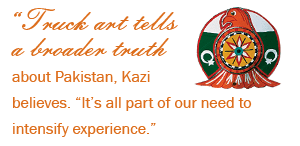 “They were badges of competition,” Kazi explains. “And the more flamboyant the design, the better business became.”
“They were badges of competition,” Kazi explains. “And the more flamboyant the design, the better business became.”
Although truck decoration initially mimicked motifs that had been found on camel caravans and oxcarts for thousands of years, the practice took a quantum leap in the 1950’s when Hajji Hussain hit town. Renowned for the stylized murals and frescoes he painted in palaces in his native Gujarat province in India, on the border with Pakistan, Hussain settled in Karachi when he married a local woman.
With palaces in short supply in working-class Karachi, Hussain cleverly shifted gears, adjusting his flair for subtle line and shading to the task of embellishing horse carriages and trucks with discreet floral borders. The decoration did not remain discreet for long, as its appeal quickly led to its enveloping the entire exterior surfaces of the vehicles.
In the 1960’s, the country’s economy boomed and, along with it, the transportation industry. The Bedford, a British-built truck with a rounded cab and 2.3-meter-high (7') paneled sides that give it a precarious, top-heavy look, became the prestige truck of choice. Not by chance, Kazi soon discovered: The son of Muhammad Ayub Khan, Pakistan’s president from 1962 to 1969, set himself up as the country’s sole Bedford dealer and made sure that Bedfords were the only trucks imported into the country. (Locally manufactured trucks were no competition.) “The style of painting and dec-
oration evolved to fit the Bedford like a glove,” Kazi says.
Mockingly dubbed “rockets,” the lumbering Bedfords made up for their snail’s-pace acceleration with virtual indestructibility, indefatigably chugging along a quarter of a
century and more after they first rolled off the assembly lines. “The owners don’t mind changing engines. It’s the chassis that is so precious,” Kazi explains. “Original Bedford springs, for instance, are like gold for truckers.”
When Bedford’s parent company, Vauxhall, stopped production of the much-loved Bedfords some 13 years ago, Japanese imports like Hino, Nissan and Isuzu supplanted them. “Even though the Japanese trucks have better fuel economy, superior brakes, longer wheelbases and bigger windshields, there’s still nostalgia for the Bedfords,” reckons Kazi. “It’s only recently that the decorative panels, carving and accessories have somewhat grudgingly been adapted to fit these newer trucks.”
During the 1960’s and 1970’s, the increasing sophistication of truck decoration began to reflect the growing wealth of the drivers and the rise of a new urban class. “People who had come from poor village backgrounds suddenly had money,” Kazi observes. “They were richer than their parents and ancestors and wanted to show off their new-found confidence, position and authority.” For rival truck and bus owners jostling for business, dueling paint jobs became essential for gaining a competitive edge.
Boldly speculating where only academics—and certainly not the artists themselves—dare to tread, the professor draws a parallel between contemporary truck design and the exquisitely refined court decoration of 16th- and 17th-century Mughal emperors. In Kazi’s view, truck cabs boasting a profusion of dangling mirrors and fringed silk and satin embroidery are direct descendants of the Sheesh Mahal (“mirror palace”), sumptuous halls of mirrors and brocade found in palaces and forts in Lahore, Patiala, Jaipur and Agra.
“The Mughals loved this play of light where one candle could illuminate a vast hall,” remarks Kazi. “Why not truck artists and drivers?”
Some of the more popular landscape scenes, those depicting the hunt, lions, grouse, deer, hunting lodges or mountain chalets, are taken straight out of Mughal court painting,
she maintains.
Later, when a visitor tries to describe Kazi’s theory of the Mughal connection to Haider Ali, the veteran painter flashes a puzzled, indulgent smile. It’s clear he’s not buying it.
“I paint from photos the drivers bring me, designs they point out on other trucks, anything they want,” he says. “And if they don’t know what they want, I make up scenes from my imagination.”
Generally, the painting follows an informal, unwritten grammar. The taj, or prow, above the cab is customarily reserved for mosques and other holy monuments. Side panels fizz with waterfalls, lakes, mountains, landscapes, hunting lodges and animals. The rear of the truck is typically emblazoned with a single large portrait encircled by flowers, vines and geometric configurations.
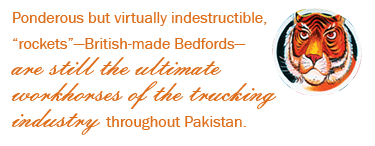 One recent trend speaks volumes about the emerging fortunes of truck owners and drivers. Instead of putting someone famous in the place of honor on back of their trucks, some drivers have commissioned portraits of their sons. “It’s part of the country’s newfound upward social mobility,” says Kazi. “Now, truck drivers feel they don’t have to boost their status with celebrities; their own sons are good enough.”
One recent trend speaks volumes about the emerging fortunes of truck owners and drivers. Instead of putting someone famous in the place of honor on back of their trucks, some drivers have commissioned portraits of their sons. “It’s part of the country’s newfound upward social mobility,” says Kazi. “Now, truck drivers feel they don’t have to boost their status with celebrities; their own sons are good enough.”
When a new truck comes in for outfitting, it is totally bare bones, with only a cab and a chassis—albeit invariably reinforced to within an inch of its life. Six-wheel rigs designed to carry five-ton payloads are routinely bolstered to haul 10, 15, even 20 tons. Used trucks are overhauled according to the owners’ wishes and pocketbooks, ranging from simple paint jobs all the way to complete makeovers
of bodywork and decorative art.
Like a medieval guild, the division of labor in truck and
bus workshops is highly demarcated, with individual artisans responsible for each stage of the process. One person is in charge of erecting frames of steel ribs over flatbed floors of hard pine and, for buses, covering the frames with steel and plastic shells. (Ordinarily, cargo in open trucks is wrapped in tarpaulins strapped down by ropes or simply left uncovered.) Separately, an electrician installs wiring while a metalworker fashions dangling steel balls, hammered-steel mud flaps and shiny leaf chains. The carpenter who carves arabesque inlays on cab doors and taj crowns of walnut or deodar cedar is distinct from the upholstery specialist who stitches beadwork into fancy cab-seat cushions and embroiders cloth flaps on windows with gold and silver thread. While a master artist like Haider Ali paints large portraits and landscapes, he commonly relies on an assistant to fill in backgrounds and borders. In a culture that puts great stock in poetry, there are even a handful of scholars and poets whom drivers commission to write original poetic inscriptions for their trucks or search out a few well-turned phrases by other authors.
“One classic line,” says Kazi, is “‘If your mother prays for you, it’s like a breeze from heaven.’” Other selections, particularly on buses, are racier, like the teasing, convoluted come-on that reads, “I wish I were the book you are reading, so that when you fall asleep and the book falls on your chest, I would be so close to you.” In general, she points out, trucks display themes of distance, the journey and spiritual longing, while “90 percent of the messages on buses have to do with love, particularly unrequited love.” (Rickshas, with far less space, make do with a cryptic word or two like “I wish” or “broken pearl.”)
“Sometimes you have no idea what they mean,” laughs Kazi.
Like western pictorial allusions and the imported trucks themselves, many of the materials used in truck decoration also come from outside Pakistan, and they are put to uses the manufacturers never dreamed of. Shipped into the country in 10-centimeter-wide (4'') rolls, reflective tape from Germany and Japan is cut, shaped and layered to create fantastical compositions. “Because the roads were not lit, reflectors were essential,” Kazi explains. “But truck decorators turned this pragmatic necessity into an excuse to go wild.”
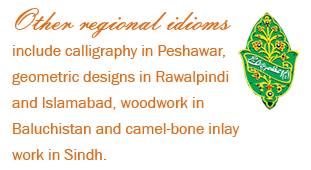 Although Karachi is the country’s principal center for truck decoration, other regions have evolved their own signature idioms. In Peshawar, trucks sport far more calligraphy than illustration. In Rawalpindi and Islamabad, designers cut out colored plastic sheets and layer them to create unusual patterns and geometric effects over the truck exterior. Artisans
in Baluchistan and Peshawar are esteemed for their magnificently detailed woodwork carved on cab doors and interiors. Camel-bone inlay is emblematic of Sindh, while stainless-steel peacock appliqués are popular both in Sindh and the Punjab.
Although Karachi is the country’s principal center for truck decoration, other regions have evolved their own signature idioms. In Peshawar, trucks sport far more calligraphy than illustration. In Rawalpindi and Islamabad, designers cut out colored plastic sheets and layer them to create unusual patterns and geometric effects over the truck exterior. Artisans
in Baluchistan and Peshawar are esteemed for their magnificently detailed woodwork carved on cab doors and interiors. Camel-bone inlay is emblematic of Sindh, while stainless-steel peacock appliqués are popular both in Sindh and the Punjab.
Frequently, truck decoration mirrors the country’s demographic shifts. When Kashmiri woodcarvers migrated south to Karachi in the mid-1980’s to escape fighting in their homeland, many found work refurbishing trucks. Their spidery filigree tracery soon began to pop up on the doors and taj crowns of local vehicles.
For such a vibrant industry, supercharged with color, the future, unfortunately, looks distinctly gray. Unlike the current generation of painters, body workers and decorators who learned their trades from their fathers, uncles and older brothers, the upcoming generation shows little interest in following in their relatives’ footsteps. Nor do their parents necessarily want them to.
Take 40-year-old Abdul Aziz, who started painting at
age 15 in his father’s workshop. “Business is not good now because there are too many truck artists,” sighs Aziz in his blisteringly hot bus-painting atelier in the Landhi district of east Karachi. “My son will have a better future if he finishes school and takes up a more secure profession.”
Still, with all the irrepressible energy that goes into truck decoration, it’s hard to imagine this quintessentially Pakistani craft dying out any time soon, particularly with painters like Master Shahid Sahab around to renew the tradition.
“Master Sahab paints crazy, wacky things like army officers waterskiing, a Saracen warrior slaying Godzilla, mythic Greek heroes in togas,” chuckles Kazi. “Then he’ll put plastic lovebirds on the dashboard and a ludicrous-sounding horn that blasts out a wolf whistle. I love this kind of madness.”
Somehow, you feel sure that the rest of Pakistan does, too. For optimists like Kazi, who shudder at the unthinkable prospect of the country’s roads becoming as drab as any garden-variety interstate or autobahn, this moveable feast of imagery is nowhere near a dead end.
 |
Paris-based author Richard Covington ([email protected]) writes about arts, culture and the media in Europe, the Middle East and Asia for the International Herald Tribune, the Los Angeles Times, Smithsonian, Reader's Digest and other publications. |
 |
Shahidul Alam is the founder of Drik Picture Library (www.drik.net), the Bangladesh Photo Institute and Pathshala (The South Asian Institute of Photography), as well as the biennial Chobi Mela Festival of Photography in Asia. He lives in Dhaka. |





